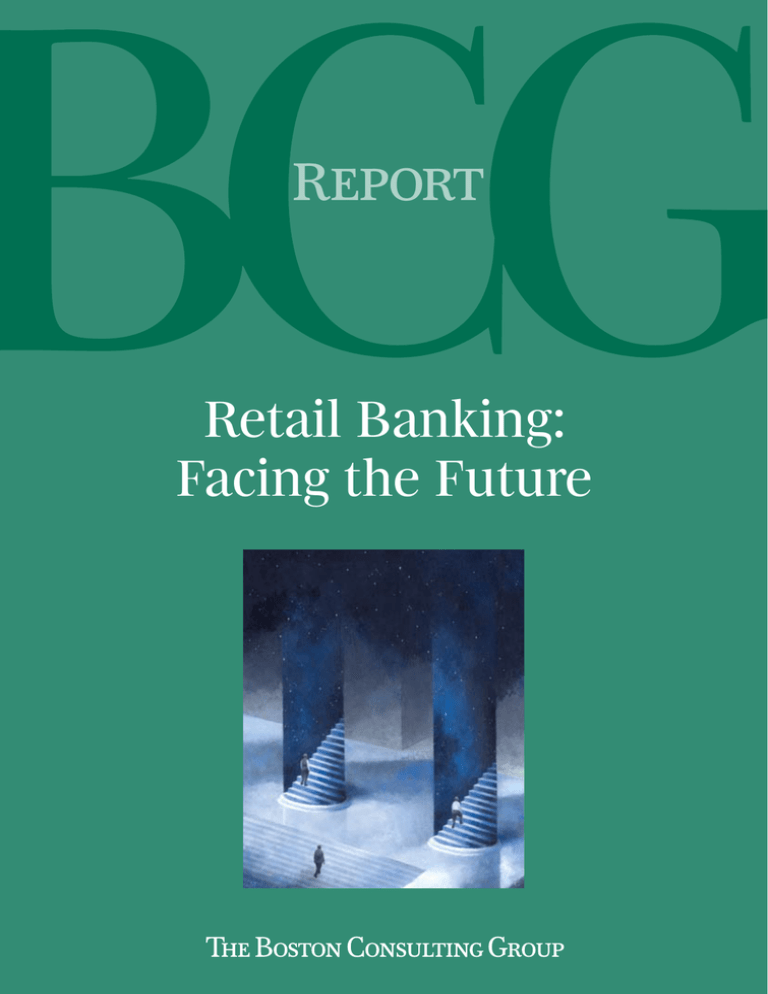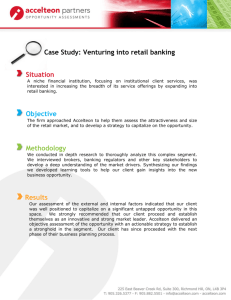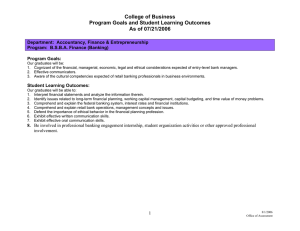
Report
Retail Banking:
Facing the Future
The Boston Consulting Group (BCG) is a global management consulting ʮrm and the world’s leading advisor on
business strategy. We partner with clients in all sectors
and regions to identify their highest-value opportunities,
address their most critical challenges, and transform their
businesses. Our customized approach combines deep insight into the dynamics of companies and markets with
close collaboration at all levels of the client organization.
This ensures that our clients achieve sustainable competitive advantage, build more capable organizations, and
secure lasting results. Founded in 1963, BCG is a private
company with 66 oʯces in 38 countries. For more information, please visit www.bcg.com.
Retail Banking:
Facing the Future
Reinhold Leichtfuss
David Rhodes
Carlos Trascasa
Steven Chai
Monish Kumar
Raphael Schmidt-Richter
November 2007
bcg.com
© The Boston Consulting Group, Inc. 2007. All rights reserved.
For information or permission to reprint, please contact BCG at:
E-mail: bcg-info@bcg.com
Fax:
+1 617 850 3901, attention BCG/Permissions
Mail: BCG/Permissions
The Boston Consulting Group, Inc.
Exchange Place
Boston, MA 02109
USA
Contents
Note to the Reader
5
Preface
6
Executive Summary
7
Revenue Pools in Motion
10
An Ever-Toughening Competitive Landscape
15
Declining Regulatory Barriers, Increasing Rivalries
15
Deeper Regional and Global Footprints
15
More Direct, More Online Banking
16
Customers with Higher Expectations
19
The Tightening Grip of Margin Pressure
20
A Powerful Force
20
A New Structural Equilibrium
20
More Competition, More M&A Deals
24
Winning Business Models of the Future
26
Global Titans and Regional Expansionists
26
Domestic Champions
28
Retail-Oriented Attackers
28
Direct Banks
29
Specialists
30
Trading-Up Players
30
A Fight on Many Fronts
31
Defending and Growing at Home
31
Exploiting the Power of Process
33
Building Meaningful Positions in High-Growth Markets
36
For Further Reading
38
RĊęĆĎđ BĆēĐĎēČ
ȶ
ȷ
TčĊ BĔĘęĔē CĔēĘĚđęĎēČ GėĔĚĕ
Note to the Reader
About the Authors
For Further Contact
Acknowledgments
Reinhold Leichtfuss is a senior
partner and managing director in
the Frankfurt oʯce of The Boston
Consulting Group. David Rhodes is
a senior partner and managing
director in the ʮrm’s London oʯce.
Carlos Trascasa is a senior partner
and managing director in BCG’s
Madrid oʯce. Steven Chai is a
senior partner and managing
director in the ʮrm’s Seoul oʯce.
Monish Kumar is a partner and
managing director in BCG’s New
York oʯce. Raphael SchmidtRichter is a project leader in the
ʮrm’s Frankfurt oʯce.
If you would like to discuss the
themes and content of this report,
please contact one of the following
leaders of our global retail-banking
practice:
We would like to thank the executives and institutions that participated in our Global Retail Banking
2007 research eʫort and helped
enrich this report. We would also like
to thank our project team consisting
of Jarod Avila, Thorsten Brackert,
Kirsten Duda, Viktor Lee, Jens
Muendler, Toby Owens, Miguel Pita,
Øyvind Torpp, and Ute Wellnitz.
Europe
Reinhold Leichtfuss
BCG Frankfurt
+49 69 9 15 02 0
leichtfuss.reinhold@bcg.com
The Americas
Monish Kumar
BCG New York
+1 212 446 2800
kumar.monish@bcg.com
Asia-Paciʮc
Steven Chai
BCG Seoul
+822 399 2500
chai.steven@bcg.com
Global
Carlos Trascasa
BCG Madrid
+ 34 91 520 61 00
trascasa.carlos@bcg.com
RĊęĆĎđ BĆēĐĎēČ
Many senior leaders of BCG’s
Financial Services practice provided
us with valuable insights and helped
us conduct our research. They
include Lionel Aré, Satyendra
Chelvendra, Michael Grebe, Rune
Jacobsen, Huib Kurstjens, Andy
Maguire, Janmejaya Sinha, Knut
Storholm, Tjun Tang, and Andrew
Westergren.
Finally, we would like to thank Philip
Crawford for his editorial guidance,
as well as other members of the
editorial and production staʫ,
including Katherine Andrews, Gary
Callahan, Kim Friedman, and Sara
Strassenreiter.
ȸ
Preface
W
ith myriad trends shaping the global
retail-banking landscape, it is sometimes diʯcult to see the big picture
through the clutter of news and information that so oʶen blocks a clear
view of highly complex industries. Yet the fact remains
that the retail segment brings in nearly 60 percent of total
banking revenues worldwide. It is therefore critical that
banking executives gain a clear perspective on the forces
that are driving the industry’s future.
boom populations, particularly in the West and Japan,
and more youthful populations in other regions will present fresh challenges for retail bankers. BCG’s recent research on aʵuent middle-aged customers in the Americas reveals a surprisingly underserved preretirement
market. Moreover, youthful customer bases, as comfortable with the Internet as their parents were with the
ʮxed-line telephone, will speed up the already rapid rate
at which direct and online banking are ʴowing into the
mainstream.
There are many forces in play. Traditional barriers to
open markets—both regulatory and political—are falling
around the world and should continue to crumble, piece
by piece. At the same time, maturing markets and signiʮcant consolidation in highly developed Western economies are forcing major players to sharpen their value
propositions at home and broaden their horizons internationally in search of new revenue pools. As domestic
battles for diʫerentiation become ʮercer and as numerous players attempt to plant ʴags in the same emerging
markets, overall competition in the industry is becoming
more and more intense. Margins, already under pressure
in recent years, are being whittled down by this competition and should continue to erode gradually.
The well of information that the Internet provides is also
playing a role in the increasing ʮnancial astuteness of
many retail-banking customers. This astuteness makes
clients more willing to shop around for the best products
and services, and will make them that much more diʯcult for retail bankers to please and retain in the future.
Also, the continuing development of emerging markets—
most notably China, India, Latin America, and Eastern
Europe—will oʫer opportunities. In Asia-Paciʮc alone,
hundreds of millions of consumers that are not yet part
of the banking system will seek banking services.
In addition to the demographics of ʮnancial exclusion,
the demographics of age will be important. Aging baby-
ȹ
It was with thoughts such as these in mind that The Boston Consulting Group undertook a signiʮcant research
project. This eʫort was aimed at helping retail banks
identify the key trends that are aʫecting the industry, recognize the challenges they are likely to face both at home
and abroad, and acquire the new skills and capabilities
needed to be a market leader going forward. Retail Banking: Facing the Future is a direct result of this work.
We hope this report will be thought provoking and serve
as a source of useful information for senior retail-banking
executives seeking both to develop a diʫerentiating and
successful strategy and to take the performance of their
institutions to the next level of excellence. For it is these
banks that will determine the true nature of the future of
retail banking.
TčĊ BĔĘęĔē CĔēĘĚđęĎēČ GėĔĚĕ
Executive Summary
R
etail banking will remain the dominant
source of revenue for banks worldwide
through 2015. In 2006, the retail banking
business accounted for €1.22 trillion in
revenues, or about 57 percent of the
global banking revenue pool of €2.15 trillion.
consumers in China, India, and Brazil were to generate
50 percent of the revenues currently provided by
“banked,” low-income customers in these countries,
the amount of total new revenues produced by 2015
in these markets could be above €20 billion—the bulk
likely coming from China.
ʘ Fourteen banking groups earned retail revenues in excess of €10 billion in 2006, with ʮve groups bringing in
more than €25 billion each. Even for most of the top
ten banking titans, retail business is still a critical revenue source—representing an average of 37 percent of
total revenues.
Competition in the global retail-banking industry will
become increasingly intense, driven by the continuing deregulation and opening of international markets, the ongoing regionalization and globalization of
the industry, the expansion of direct and online banking, and rising customer expectations.
ʘ Through 2015, retail revenues will expand at an estimated compound annual growth rate (CAGR) of 3.2
percent in real terms. Factoring in an inʴation rate of
roughly 3 percent, overall growth should add up to
about 6 to 7 percent. The retail banking business also
continues to deliver a higher return on equity (ROE)
than other banking segments. Most major banks currently achieve ROE above 25 percent (before taxes)
from their retail banking activities.
ʘ The number of new entrants with attacking mindsets
in regional markets will increase. Aggressive players—
be they direct banks, product specialists, or traditional
banks seeking to expand their scope—will continue to
battle incumbents with fresh price and value propositions all over the globe.
ʘ By 2015, the share of global retail-banking revenues
generated collectively in the top ʮve European countries and in the United States—which are all mature
markets—will have shrunk by an estimated 5 percent,
with matching collective gains in strongly growing
markets in Asia-Paciʮc and the Middle East.
ʘ Vast numbers of “unbanked” consumers in emerging
markets—what we call the next billion—will take up
banking relationships over the next generation. If such
RĊęĆĎđ BĆēĐĎēČ
ʘ The well-known trend towards direct and online banking will change the nature of the industry signiʮcantly
in terms of channel usage. This trend will gain momentum as adoption rates across all age groups increase
and as more young people—who have been raised using the Internet—reach bankable age. This dynamic
will inevitably lead to a further decline in the importance of bank branches for some sales activities, although branches will remain critical for customer acquisition and advice-intensive products.
ʘ The transparency of the online world and the ability
of sophisticated consumers to compare oʫers and
Ⱥ
price positions will push the pendulum of power in
the retail banking industry increasingly towards the
customer, thus further pressurizing the competitive
landscape.
The grip of margin pressure will continue to tighten.
From 2001 to 2006, the banks in our benchmarking
survey showed average margin declines in their retail
segments of about 21 percent.
ʘ Many attackers possess highly cost eʯcient and scalable business models that allow them to oʫer cheaper
prices on a sustained basis. This fact, along with the
ongoing shiʶ towards online and direct banking, will
lead the industry toward a new structural equilibrium
at lower margin and cost levels.
ʘ In some markets, attacking players have already taken
sizable share from incumbents that have been reluctant to ʮght proactively on the price front. This trend
will gain momentum as more new competitors enter
the fray. Incumbents will either have to oʫer commodity products for certain segments at competitive prices
or accept loss of market share.
ʘ A key result of heavy price competition and its expansion into a wide range of products is that revenue
pools will grow at a lower rate in many major markets
over the next few years. This will make it necessary for
banks to drive down their cost growth in order to keep
cost-to-income ratios and proʮtability levels stable—
let alone achieve more ambitious targets. Resizing
and restructuring platforms to help achieve this
will be a tall challenge for many banks over the next
decade.
Tougher competition and tighter pressure on margins and costs will encourage increasing merger and
acquisition (M&A) activity, especially in mature markets with low growth rates.
ʘ In the future, we will see bigger, diʫerently structured,
and increasingly international deals. Given the current speed of both M&A activity and the forging of
alliances, especially in the Asia-Paciʮc region, it is
very likely that by 2015 there will be ʮve to ten truly
global banks.
Ȼ
ʘ Cross-border mergers should be seen as having two,
three, or more phases to allow suʯcient time for factors such as platform, scale, and market dominance to
come into play—and for all potential synergies to materialize.
The winning business models of the future have been
taking shape in recent years and will continue to
evolve. These models are exempliʮed by six general
types of retail banks: global titans and regional
expansionists, domestic champions, retail-oriented
attackers, direct banks, specialists, and trading-up
players.
ʘ The ʮrst ʮve categories of players have clearly outperformed the pack or showed the strongest improvements in recent years. They have an average advantage
in their cost-to-income ratio of 10 percentage points,
an average ROE advantage of 10 percentage points,
and a revenue growth rate more than twice that of
most other banks. They also dare to invest in organic
growth and in acquisitions—their top-line growth allowing cost growth three times as high as that of most
other players. The sixth category, trading-up banks, is
well positioned to catch up in the future, especially if
the leading players maintain focus and expand more
aggressively.
ʘ Between 2001 and 2006, direct banks and retail-oriented attackers showed the sharpest revenue growth
of the six groups, with a CAGR above 20 percent, and
at the same time achieved signiʮcant improvements in
cost-to-income ratios. Nonetheless, despite direct
banks’ strong inʴuence on overall industry margins
and channel strategies, the largest share of direct and
online banking will remain with multichannel banks.
All models will show a stronger online proʮle going
forward, and some interesting new combinations may
evolve as new players arrive on the scene.
Over the next ten years, traditional incumbents will
ʮnd themselves more engaged than ever on several
fronts.
ʘ Incumbents will need to develop sharper positioning
and coherent new business models in order to defend
their home markets and ʮght for share against an in-
TčĊ BĔĘęĔē CĔēĘĚđęĎēČ GėĔĚĕ
creasing number of attackers. Because they have mature footprints, many incumbents seeking competitive
advantage will turn to product innovation and bettering customer service. Products and pricing should remain easy to copy, the latter providing sustainable
advantage only to low-cost players. Yet a small number
of retail banks will realize long-term advantage by
delivering a diʯcult-to-copy superior customer experience.
ʘ Incumbents will also need to make direct and online
banking a stronger part of their multichannel strategies and upgrade their skills in online customer acquisition and loyalty management. Winners will learn
quickly from other industries and will transfer recipes
for success to retail banking.
ʘ To deliver a superior customer experience and achieve
better cost eʯciency, incumbents will need to fully exploit the power of process. On average, cost savings of
15 to 30 percent can be achieved through improved
process eʯciency, internally shared services, and outsourcing and oʫshoring. Strong consolidators can go
even beyond that level. The continuing deconstruction
of the value chain will help banks improve eʯciency
and ʮght margin pressure. A number of incumbent
banks, however, may not be able to close process eʯciency gaps.
ʘ Incumbents will also need to build meaningful presences in chosen emerging markets that oʫer the steepest growth potential. Simply planting ʴags in numerous markets and achieving meager shares will not be
a successful and value-creating strategy.
ʘ Most future winners will have to be strong acquirers
and integrators. Those that want to lead in emerging
regional markets should be prepared to initiate at least
one or two major mergers or acquisitions over the next
ʮve to ten years. Such moves can serve as powerful
levers for defending market positions, widening scope,
and increasing eʯciency.
RĊęĆĎđ BĆēĐĎēČ
ȼ






